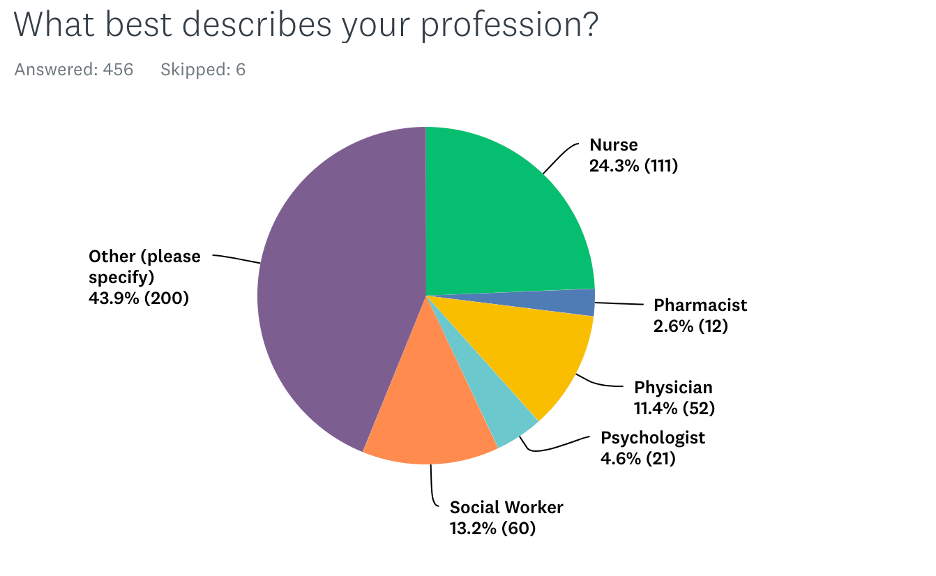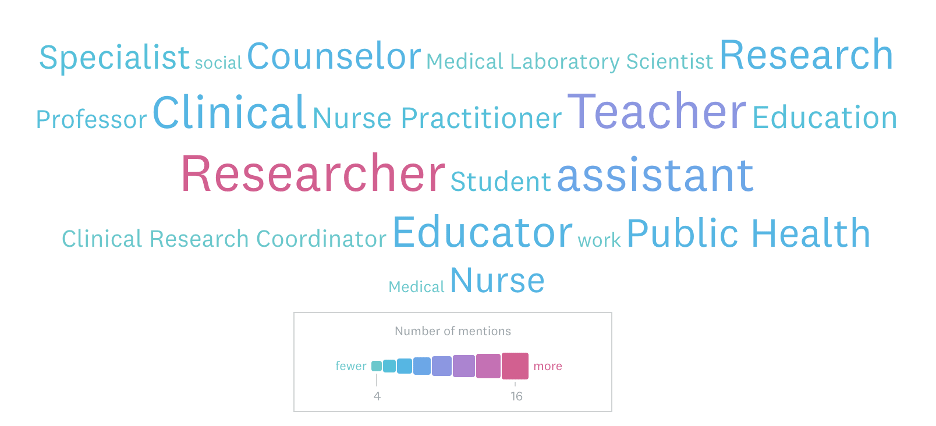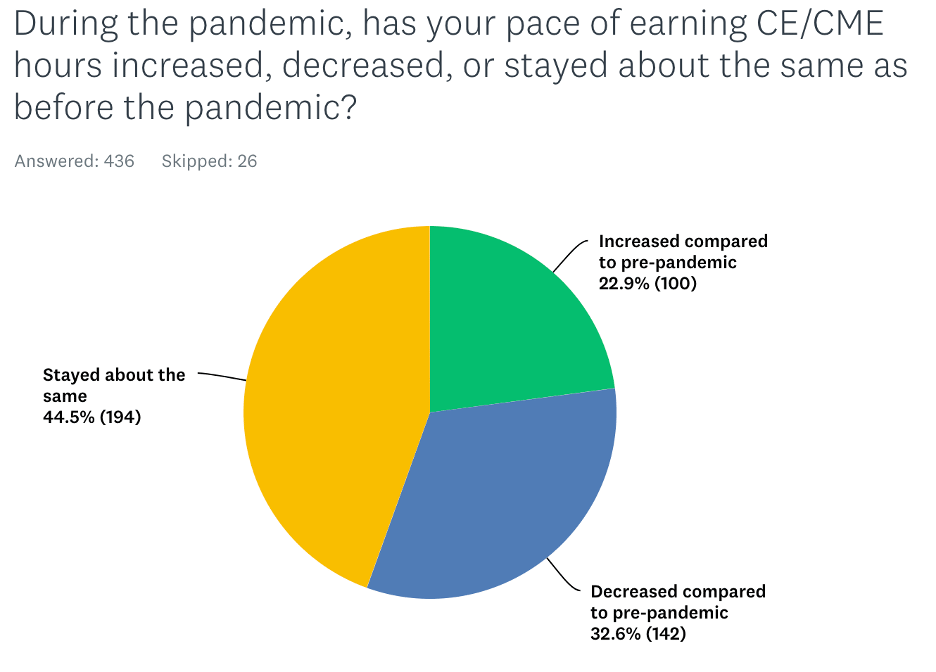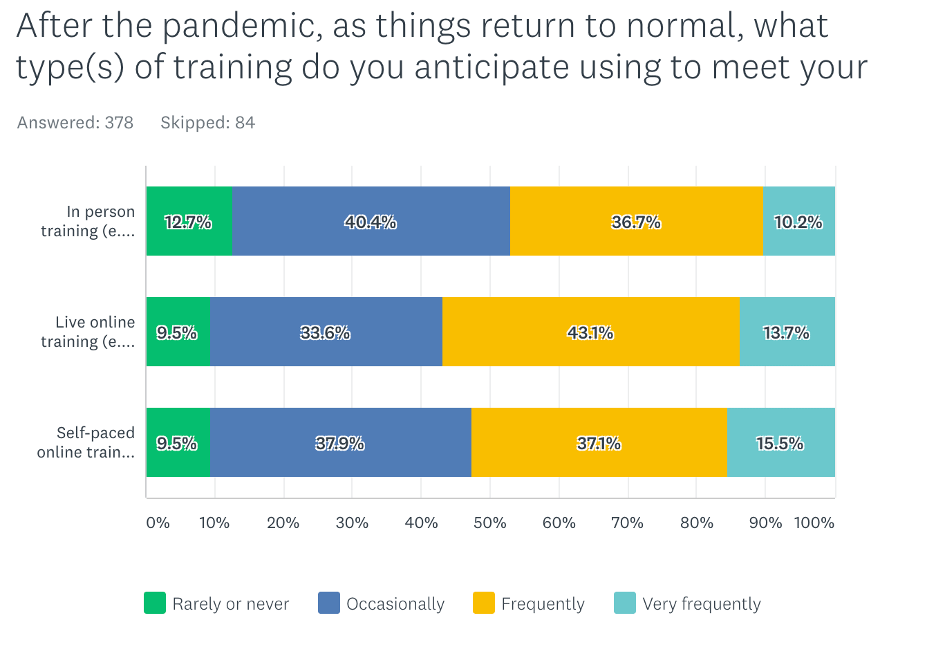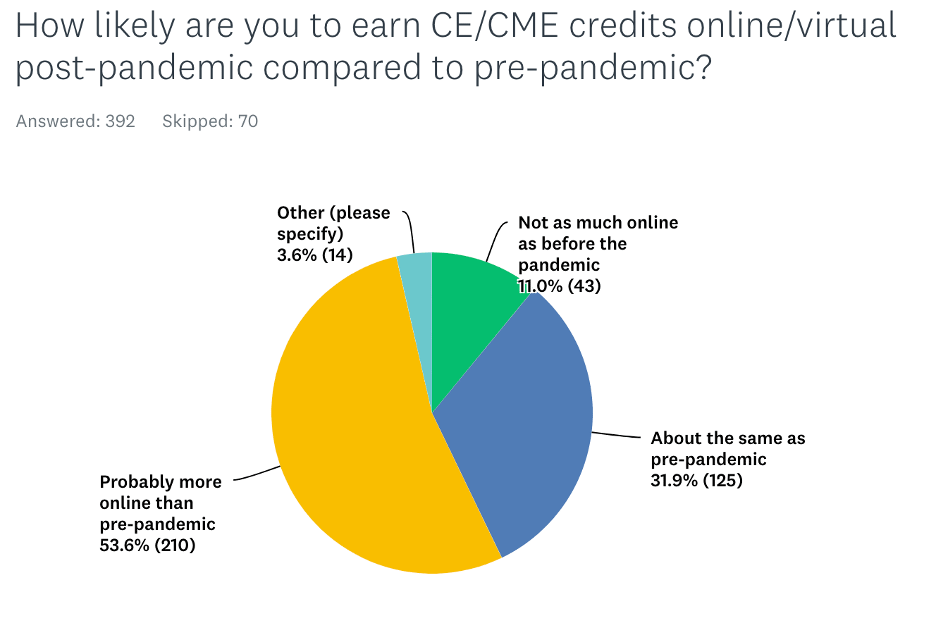In June 2021, as the number of COVID-19 infections, hospitalizations, and deaths significantly decreased, and before the prevalence in the US of the COVID-19 Delta and Lambda variants, we surveyed a sample of our learners who had been actively involved in obtaining CE credit online regarding their perspective on current and future participation in continuing education using in-person and virtual formats. The survey was conducted from 15-28 June 2021 and anonymously recruited participants from 250,000 persons (out of 1.5 million learners) who completed a CITI Program course in the last five years, obtained CE credit, and indicated a willingness to be contacted for such efforts.
Summary Survey Findings
- A total of 462 responses were received, and the typical time spent completing the survey was 5 minutes. While the total number of responses was lower than we expected, we considered the responders a valid and representative sample of our CE learners.
- Individuals were asked to describe their profession as physicians, nurses, pharmacists, psychologists, social workers, or others. They were asked to indicate the approximate amount of CE/CME hours earned in an average year to maintain their professional licensure or certification. The survey then asked if the participants’ pace of obtaining CE/CME picked up, slowed down, or remained the same during the pandemic; and what factors may have influenced the pace of earning CE/CME. Respondents were then asked to indicate what training they generally used to meet their CE/CME requirements before, during, and after the pandemic. Next, participants were asked what they perceived as significant barriers to meeting their CE/CME requirements going forward. Survey participants were then asked if they planned to attend an in-person/live conference for CE/CME credits in the future and how likely were they to earn CE/CME credits online/virtually post-pandemic compared to pre-pandemic. Finally, learners were asked to share anything else about their CE/CME experiences that had not been asked.
- Respondents reflected several professions such as physicians, nurses, pharmacists, psychologists, social workers. Many individuals who identified as other professions reflected various roles, including educators, clinical research professionals, physiotherapists, counselors, researchers, public health administrators, and community health workers.
- Overarchingly, the survey indicated that before the pandemic, most learners used in-person options to meet their CE/CME needs, while during the pandemic, most learners used online/virtual continuing education options. During and after the pandemic, the favored virtual CE/CME activities were live online learning experiences.
- Uncertainty regarding the pandemic is evident in written comments about future CE/CME plans. In addition, cost, time/competing priorities, and availability were identified as major barriers to meeting CE/CME requirements.
Interesting Data Points
Professions of Respondents (Question 1)
Nurses, Social workers, and physicians, respectively, were among the highest number of responses. 24.3% of respondents identified as nurses. 13.2% identified as Social Workers, and 11.4% identified as physicians. 7.2% of responses were from Psychologists and Pharmacists. Over 40% of respondents selected other when responding to this question.
Examples of other professions mentioned most frequently (43.9% in above graphic):
Average CE/CME hours earned annually (Question 2)
The average of all responses was 31 CE/CME hours earned in an average year. The median response was 30, with a mean of 31.30. The maximum amount of CE/CME hours earned in an average year was 80 credits/hours.
Factors affecting the pace of earning CE/CME during the pandemic (Question 3)
Most (44.5%) respondents reported that the pace of earning CE credits stayed about the same as their pre-pandemic pace. About a third (32.6%) of respondents indicated a decrease in pace, while 22.9% responded that their pace increased.
Factors affecting the pace of earning CE/CMEs during the pandemic (Question 4)
Availability of online CE/CME was a significant factor that affected the pace of earning credit. Most (41.9%) responders attended live online meetings and webinars, while many (29.3%) indicated that they took self-paced online courses. Other significant factors included the cessation of in-person training (25.6%) and the need to serve as a front-line worker during the pandemic (24.7%). Also of significance, several respondents (24.9%) were current with CE/CME before the pandemic, were not seeking CE/CME during the pandemic (17.4%), or were not seeking CE/CME before the pandemic (11.4%). Less than ten percent of responders (7.3%) indicated that their profession’s governing body extended recertification deadlines, while a similar proportion (7.1%) reported their institution closed during the pandemic.
A couple of recurring written comments indicated the availability of free CE, and the financial downturn impacted the pace of earning CE/CME credit.
Types of training generally used for CE/CME requirements before the pandemic (Question 5)
In-person events: Two-thirds of respondents either very frequently (18.5%) frequently (34.5%) or occasionally (33.2%) attended in-person professional CE/CME meetings, conferences, or grand rounds. The remaining responders rarely or never used in-person events to participate in CE/CME endeavors.
Live online events: Most responders used live online activities to participate in CE/CME educational endeavors. Live online events were used very frequently by 6.4% of responders, while 26.8% indicated frequent use and 42.8% indicated occasional use. About one-fourth (24.0%) of our respondents indicated they rarely or never used live online events for CE/CME.
Self-paced online training (online courses like CITI’s, other enduring materials): Nearly half (48.2%) of the responders indicated occasional use of self-paced online CE/CME. The remaining half frequently (22.5%), very frequently (10.8%), or rarely to never (18.4) used self-paced online CE/CME training).
Other written responses about training modalities before the pandemic include:
- Master’s in Education and Doctorate in Education
- Journal review with post-test
- Teaching (relevant 1st-time workshops/courses count in PA)
Types of training generally used for CE/CME requirements during the pandemic (Question 6)
In-person events: Two-thirds of respondents (68.8%) rarely or never attended in-person professional CE/CME meetings, conferences, or grand rounds. The remaining responders occasionally (18.1%), frequently (9.7%), or very frequently (3.4%) used in-person events to participate in CE/CME endeavors.
Live online events: Two-thirds of respondents indicated live online events to be the modality used to obtain CE/CME training either frequently (35.0%), occasionally (25.1%), or very frequently (19.1). About one-fifth (20.8%) of our respondents indicated they rarely or never used live online events for CE/CME during the pandemic.
Self-paced online training (online courses like CITI’s, other enduring materials): Over half of the responders indicated occasional (34.5%) or frequent (30.4%) use of self-paced online CE/CME. The remaining one-third either never or rarely (19.7%) or frequently (15.4%) used self-paced online training.
Types of training generally used for CE/CME requirements after the pandemic (Question 7)
In-person events: Most responders indicated they had occasionally (40.4%), frequently (36.7%), or very frequently (10.2%) used in-person meetings, conferences, and grand rounds to fulfill CE/CME credit requirements after the pandemic. There is a smaller though not insignificant proportion (12.7%) of our respondents who rarely or never participated in live CE/CME events.
Live online events: A high proportion (90.4%) of responders opted for live online events post-pandemic. Respectively (43.1%) used this modality frequently, (33.6%) used it occasionally, and (13.7%) answered very frequently. There was a smaller though not insignificant proportion (9.5%) of respondents who rarely or never participate in live online CE/CME events.
Self-paced online training (online courses like CITI’s, other enduring materials): Most responders indicated occasional (37.9%), frequent (37.1%), or very frequent (15.5%) use of self-paced online CE/CME. There was a smaller though not insignificant proportion of respondents (9.5%) who rarely or never participated in self-paced online CE/CME training.
Significant Barriers (Question 8)
Cost, time/competing priorities, and availability were identified as the top three major barriers to meeting CE/CME requirements. Concerning cost, the proportion of responses were the cost of attending in-person meetings (40%) and the cost of online training (30.6%). Related to cost, several respondents indicated that budget, whether their own (26.8%) or their institution’s (15.4%), was perceived as a major barrier. Of note, a significant proportion of respondents (28.4%) indicated that no major barriers were perceived.
Written comments nuanced other perceived barriers:
- The state may go back to requiring in-person training
- The internet costs are high here in Malawi
- Quality of virtual meetings such as inability to hear, screens that freeze, slides that don’t advance and go undetected by the speaker – limits learning and makes it a struggle
- The risk of contracting Covid 19 while attending in-person training
- Lack of availability of special/required
Plans for In-person/Live Conference CE/CME Credits (Question 9)
Most responses indicated the intention to attend in-person/live conferences for CE/CME credits in the future. Regarding timeframe, 11.8% indicated within three months, 16.6% indicated within three to six months, and 24.8% indicated within six to twelve months. Several responded that they were undecided (26.9%), while a significant proportion of respondents (16.1%) indicated they probably would not attend in-person/live conferences in the next 12 months.
Notable written responses included:
- Plan to attend a Nurse Practitioner Conference (in-person) in two years as a guest.
- The renewal of my license is due after 3 years (2024).
- Yes, if lockdown is lifted
- Not sure live will be offered.
- Yes, if funds are available for me.
Pre-pandemic/Post-pandemic Comparison (Question 10)
Most respondents indicated they would probably earn more online CE/CME than before the pandemic (53.6%). Nearly one-third of respondents indicated their attendance to online/virtual CE/CME events would be the same as before the pandemic (31.9%), while a lesser proportion (11%) indicated that they would not attend as much online as before the pandemic.
Written responses included:
- Depends on whether the State of Georgia accepts online CE
- Didn’t attend any yet
- Will depend 100% on cost.
Other Comments (Question 11)
- I have completed my program about two years ago and am now emerged in my work.
- Prior to renewal of my license, I made sure I had completed the required number of hours to have a smooth completion of CME requirements.
- Continue giving information.
- In-person events have additional value related to interpersonal interactions and sharing. The change of scene can also be an important part of the CE experience.
- I have enjoyed the online learning for CE, it is convenient and less time consuming than in person. However, I do enjoy in-person learning for the social networking aspect.
- Online was overwhelming at times.
- Many licensure and credentialing bodies limit the number of online credits allowed. I hope they become more flexible in future!
- The CITI training that I needed for IRB approval was informative and to the point.
- I am very interested in reviewing courses.
- I appreciated option of virtual attendance since travel and budget, even w/o a pandemic, is a limiting factor to attend popular national conferences.
- It makes a difference when content-providers have considered that audience will be remote (e.g., if/how to submit questions; readability of materials; etc.). Not all these learning experiences have been equal.
- Enjoyed online/virtual sessions; easy access, offers flexibility, could do it from many locations.
- Live and self-paced online opportunities are very welcome as we struggle for a greater population to accommodate mask and vaccination suggestions.
About CITI Program
The Collaborative Institutional Training Initiative (CITI Program) is the trusted standard in research, ethics, and compliance training. CITI Program is dedicated to serving the training needs of colleges and universities, healthcare institutions, technology and research organizations, and governmental agencies, as they foster integrity and professional advancement of their learners. Our program has built a broad reach into the well-educated research community across the US and the world. We count over 10 million learners and reach over 90% of US higher education institutions that conduct research. In addition, our courses are used at all academic medical centers in the US, and many pharmaceutical, biotechnology, and healthcare technology companies.
Survey Methodology
- Participation in the survey was voluntary.
- There were 10 survey questions. All were optional.
- Estimated time to complete the survey was 3 minutes or less.
- The survey questions did not ask for any identifying information and we did not collect any other identifying attributes like IP address.
- Survey results are presented in summary form. Any potentially identifying information provided in narrative responses have been removed before data presentation.
- This survey activity has been reviewed by BRANY IRB and determined to be exempt. BRANY IRB and CITI Program are divisions of the Biomedical Research Alliance of New York.
More information
For more information about the survey, contact CITI Program Support

